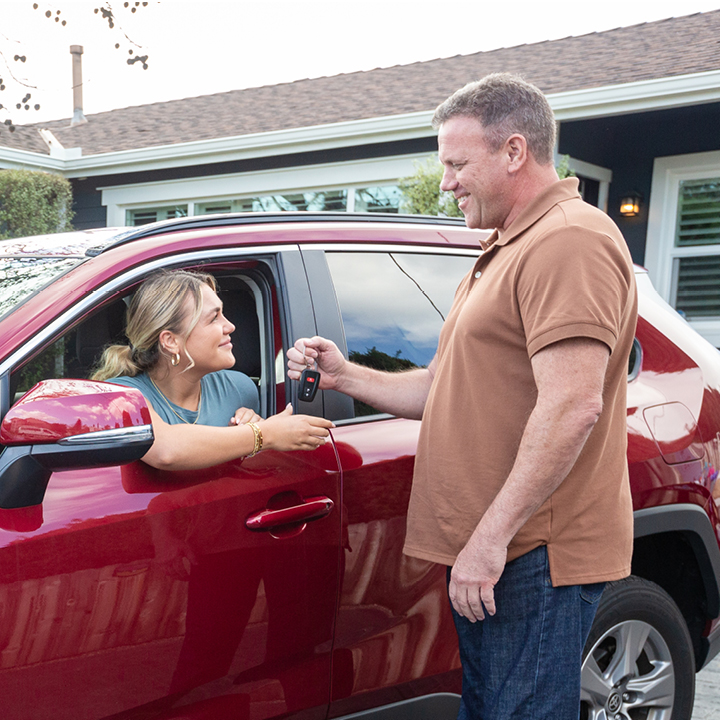- Insurance Guide
- Property Insurance
- Buy or Lease a Vehicle
Should I buy or lease a new car?

When you buy a new car — or finance a car with a loan from a bank or credit union — you’ll own the car once the payments are complete. If you maintain the car well, it could last for years after you make the final payment.
Leasing a vehicle is like renting. You’ll make monthly payments, and the car will be yours for the term of the lease. When the lease time is up, you’ll return the car to the dealership and either decide to lease a newer vehicle, purchase the car you’ve been leasing, or finance and buy another vehicle. Let’s talk about those options.
Five benefits of buying a car
- You own the car after the loan payments are finished.
- You have equity in the vehicle. If you want to trade it in toward buying a new car down the road, it’s yours to do so.
- No mileage restrictions. When you lease a car, you’re allowed a set number of miles per year. This isn’t the case when you buy a car.
- You don’t have to worry about every ding, scrape or mess. Within the 2-4-year term of a lease, a lot of wear and tear can happen, which could count against you when you turn your car in at the end. When you buy a car, you don’t have to stress about every paint scuff or soda spill on the floor.
- Customization. When you buy a car, you can order the model, color and trim package you prefer.
Five benefits of car leasing
- When you lease a car, the monthly payments will generally be lower than if you buy.
- More car for less money. Chances are, you’ll be driving a better-equipped vehicle than you might be able to afford otherwise, with the latest upgrades and safety features.
- If you continue to lease vehicles, you’re guaranteed to always be driving a new(er) car.
- Driving a newer car typically means fewer maintenance problems, and if you do experience a problem, it will probably be covered under the lease agreement or warranty.
- When the lease term is up, you simply turn the vehicle in at the dealership.
How does leasing work?
A typical lease lasts from 2-4 years. During that time, you’ll generally have a mileage limit of 12,000 – 15,000 miles per year, depending on your lease agreement. If you go over that amount, you may face fees from the leasing company at the end of your term, as well as wear-and-tear costs, which would be determined by the leasing company. You’ll also have to keep up with maintenance, including oil changes, etc., which may be included in the warranty or in the lease agreement.
As with renting, you’ll be responsible for a payment every month. At the end of the term, you’ll make a choice: Turn in the vehicle and pay any end-of-lease fees or buy the car that you’ve been leasing if there’s a purchasing option available.
How should I decide between leasing vs. buying?
First, consider your budget. Lease payments are frequently less than finance payments, so you could be able to afford a more expensive car than you might otherwise.
Second, think about your driving habits. If you drive a lot, and travel long distances, buying a car might make more sense for you. If you don’t drive frequently, or long-distance travel isn’t something you do on a regular basis, leasing might be a better bet. Car leases come with mileage limits, and if you exceed those, you will pay for them at the end of your lease term.
And third, what are your long-term plans for the vehicle? If you want to keep the car as long as possible, maintain it well and drive it long after your payments have ended, buying or financing is a good option. If you’d rather turn the car in at the end of the term, leasing a vehicle is the way to go.
Financing your new car
When buying a new car, there are a few ways to go about financing. You can either tap into a bank or credit union you’re familiar with and apply for an auto loan, or you can work with the finance department at the dealership to help find a loan with the best interest rate available to you. Credit unions can be a great option for car loans. They frequently offer very competitive rates, so don’t rule them out in your search.
The down payment, or amount of money you can pay for the car up front, will impact the terms of your car loan. If you’re able to trade your current vehicle in to the dealership as part of the payment for a new car, that will factor in as well. The less you finance, the better your terms and the lower your loan payments will be.
The term, or length, of your auto loan is negotiable. A longer loan means smaller monthly payments, but you’ll pay more interest in the end. A shorter loan means larger monthly payments, but more of your payment will apply to the principal and you’ll pay off your car sooner.
Protect yourself. Protect your investment.
Whether you lease or buy, a new car is a big investment, and you’ll want to make sure it’s well protected. Reliable auto insurance that works for your budget is a must. Look into a quote today.



